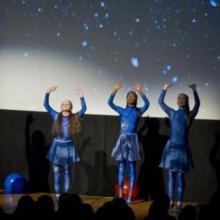
Description
The Rochester Institute of Technology's National Technical Institute for the Deaf (NTID) and Center for Computational Relativity and Gravitation (CCRG) will collaborate on a CRPA project designed to develop a dance-based performance to educate deaf and hard of hearing students on astrophysics concepts. This project seeks to address the following goals: 1) provide all audience members with access to scientific information in an inherently engaging and stimulating manner; 2) facilitate the acquisition of scientific knowledge in all audience members, including deaf and hard-of-hearing individuals, with special reference to general information and basic concepts from the fields of gravitational physics and astrophysics; and 3) stimulate general interest in STEM fields within all audience members. An extensive team of physicists, arts faculty, computer scientists, performance experts, and evaluators have assembled to translate original research on gravity-based astrophysics, including collision events between black-holes and neutron-stars, entire galaxies, and the central black-hole engine that powers active galactic nuclei, into novel educational presentations. The original science to be presented was generated in part by the scientists at the Center for Computational Relativity and Gravitation.
Project deliverables include live performances and a project website with educational materials and a virtual tour of the recorded performance. The live performances will include dance and computer generated visualizations of space phenomena, supplemented with discussion and interactive components to engage audiences both before and after the presentation. The mixed-method evaluation will provide insights into how the medium of dance can be used to engage audiences in STEM fields and increase the understanding of STEM content areas which have had little previous investigation, but may be highly relevant to the engagement of underserved audiences. Performances are planned for select sites in New York, Ohio, Connecticut, Rhode Island, Washington, DC, Pennsylvania and Maryland. It is estimated that the project will directly impact 7,000 individuals, approximately half of whom will be deaf or hard or hearing.
Deaf and hard of hearing populations are greatly underserved in science education. This project is an effort to bridge that gap by providing creative models for communicating to the public on contemporary science concepts. Learning outcomes for the target audience include increasing awareness and interest in STEM, acquisition of information and basic concepts from the fields of gravitational physics and astrophysics, and enhancing awareness of relationships among science and the arts. Project activities will be disseminated through the website hosted by the Rochester Institute of Technology, as well as social networking sites including Facebook, Twitter, and Google+. The project will also be promoted through science festivals and media events.